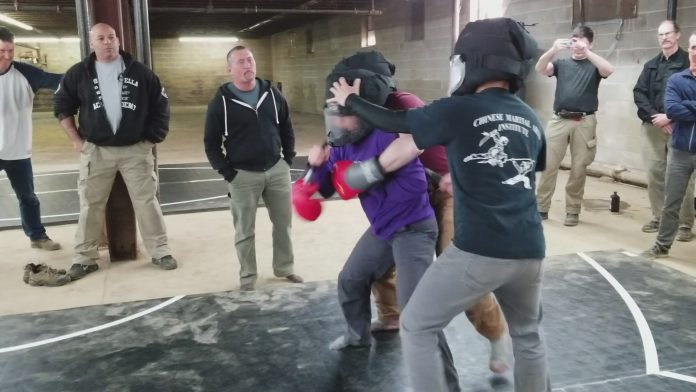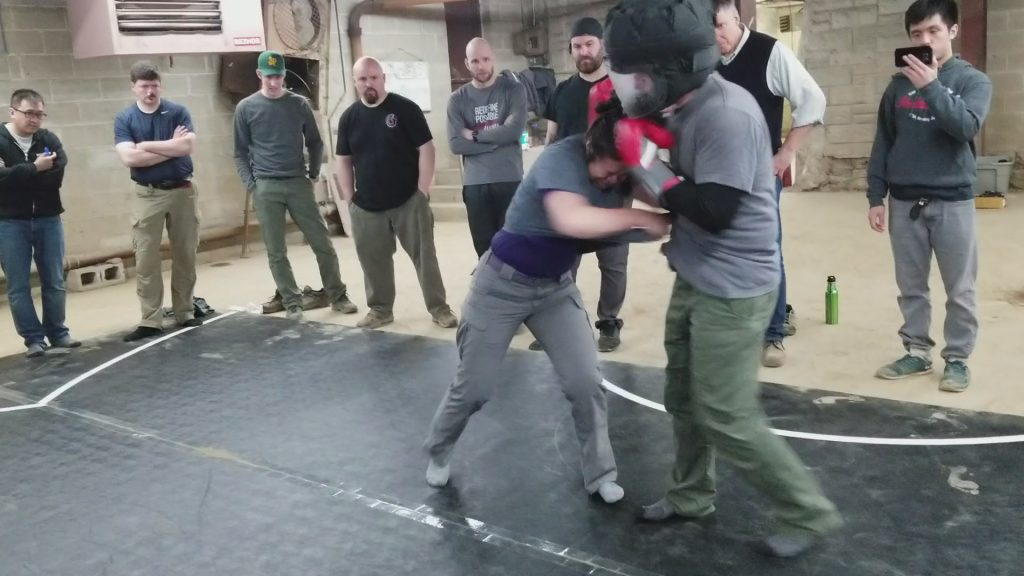
I’m a little late to the #WhyICarry party, but I’ve been busy, learning more about the realities of violent encounters. Having lived a safe, quiet, rural and suburban, upper-middle class, white collar life, the closest I’d physically been to an actual fist fight before last weekend may have been in some particularly brutal police body cam video. I’ve learned a lot about violence in theory, but I know my life is insulated. So why would I carry a gun, or any other weapon?
It seems obvious that being involved in a hands-on violent encounter would likely be a bad experience. This isn’t a mystery to most – it’s not pretty watching people getting fists and weapons driven into their faces and bodies even on grainy LiveLeak video. But like lots of people, I haven’t experienced it for real or even in a training or other not-for-realsies context.
I fixed that recently by taking Shivworks Edged Weapon Overview from Craig Douglas. I spent much of my time in class grappling with men of all sizes using fists and (trainer) knives. Coming from zero, it was hard and most of what I learned reinforced that while I can do a lot to avoid confrontations, once I’m in one, I cannot rely on just my body and skills to be enough to fend off my attacker.

Even with more training and practice time, I will have a very, very difficult time ever coming out ahead unless I have a force multiplier like a knife or gun available. It’s several days after class and not all of my bruises have finished showing up yet, even though my training partners all scaled appropriately so that I could learn and practice against reasonable, yet still difficult, opponents.
As we progressed to higher speed, higher intensity sparring sessions and training evolutions, it became abundantly clear to me how much even small men outweigh and outmuscle me. They were faster than my untrained self, hit harder, had longer reach, and were stronger overall. While the guys didn’t go easy on me, they did hold back. It was still an all-out battle for me to keep up and try to hold my own in the faster, harder evolutions.

One major outcome of the weekend for me was the ability to articulate more clearly why going hands-on with pretty much ANY adult-sized man is easily a potentially deadly event for me and one that justifies my use of lethal force in self-defense. Bare hands are, in fact, enough to kill me, and I can speak now to my reasonable and objective fear of immense physical harm even under controlled conditions.
And that means knives and guns, carried on me, are a necessity. A knife, because it’s more flexible to get to and use, and a gun because it’s more effective at physiologically stopping a threat.
A knife can do the job of discouraging an attacker and ending a violent encounter, but it still takes a certain physicality – strength, speed, the ability and willingness to hit hard. One can be used to keep an attacker from closing in, but it still generally requires being within arm’s reach. Not really where I want to be and stay if I don’t have to. Regardless, a blade is unlikely to get the attack to stop in the moment instead of after I am already injured or dead.
A gun, though. If I can get that gun out, I might be able to hold off an attacker from further away. I can stop him from hurting me more quickly and with more finality than a knife because a gun is more able to injure an attacker in a way where he physically can’t attack me anymore. I don’t have to just change his mind and make him decide that he didn’t want to hurt me after all.
That physical stop is easier with a gun, yes, and that’s not a bad thing. The faster a violent encounter ends, the less time I’m under attack, the more likely I’ll escape without major injury. It’s true that I may not be able to get to my gun, but that doesn’t make it a less effective equalizer when and if I can during a violent encounter.
The circumstances of my life are safe. Statistically, it is unlikely I will be the victim of violent crime. That doesn’t mean it can’t happen, however, or that my life won’t change. And besides, as John Hearne says, “It’s not the odds, it’s the stakes.” If I draw the unlucky short straw one day, I’d like to have the best and most effective tools available to fight on for another day.

Because in the end I consider owning the tools of self-defense, including guns, getting the training to use them effectively and having the willingness to employ them if necessary to be the most feminist statement I can make. That I and only I have the right to determine, by force if necessary, who can touch or affect my body.



